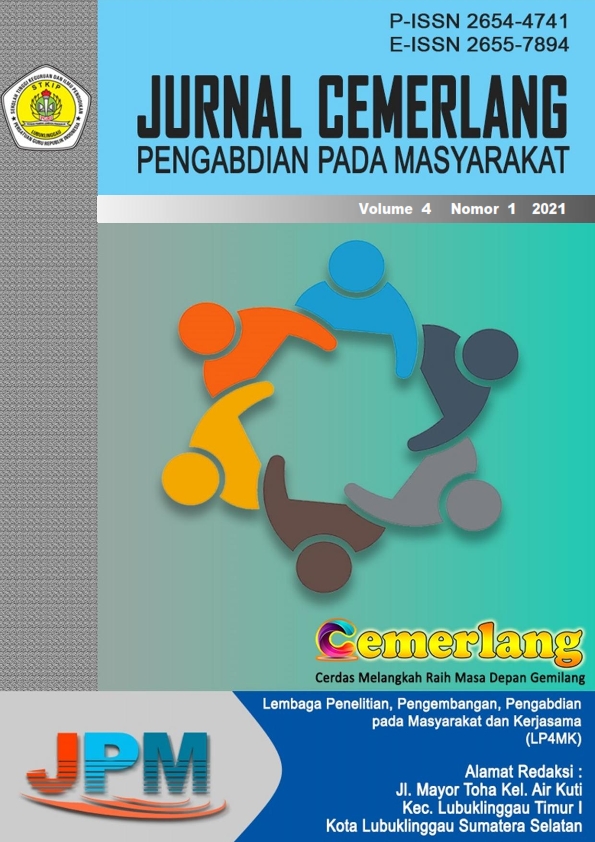PELATIHAN PEMBUATAN MINYAK ATSIRI DAUN PSIDIUM GUAJAVA L. MELALUI PROSES DESTILASI DI DESA MEGANG SAKTI III KECAMATAN MEGANG SAKTI
Abstract
Currently, many aromatic essential oils are developed from various types of leaves found in Indonesia. One of the leaves that have the potential to produce aromatic essential oils is guava leaf. Various guava leaves have been widely used as essential oils, but there is a new variety of guava leaves that has not been used as essential oil, namely crystal guava leaves. Crystal guava leaves have many benefits because crystal guava leaves contain several volatile compounds and have a strong distinctive aroma, so guava leaves have the potential to produce essential oils. The crystal guava plant is one of the leading commodities in Megang Sakti III Village, this is indicated by the many crystal guava plantations throughout the Megang Sakti III District, besides that the use of crystal guava leaves is still relatively mediocre, as if it is only used as a diarrhea medicine and the rest is not used. thus attracting the interest of TIM in carrying out PPM activities in the village by training in making essential oil from guava leaves using the distillation process. Essential oils are oils obtained from plant parts by means of steam distillation or water distillation. Essential oil from crystal guava leaves is very potential to be used as an antimicrobial and antioxidant.
References
Daud, M. F., Sadiyah, E. R., & Rismawati, E. (2011). Pengaruh Perbedaan Metode
Ekstraksi Terhadap Aktivitas Antioksidan Ekstrak Etanol Daun Jambu Biji
(Psidium guajava L.) Berdaging Buah Putih. Prosiding SNaPP, 2(1), 55-62.
Fratiwi, Y. (2015). The Potential of Guava Leaf (Psidium guajava L.) For Diarrhea.
J MAJORITY, 4(1), 113-118.
Hapsoh, & Hasanah, Y. (2011). Budidaya Tanaman Obat dan Rempah. Medan:
USU Press.
Maulana, E. A., Asih, I. A., & Arsa, M. (2016). Isolasi dan Uji Aktivitas Antioksidan Senyawa Flavonoid dari Ekstrak Daun Jambu Biji Putih (Psidium guajava L.). Jurnal Kimia, 10(1), 161-168.
Mittal, P., Gupta, V., Kaur , G., Gaug, A., & Singh, A. (2010). Phytochemistry and
Pharmacological Activities of PSidium guajava. IJPSR, 1(1), 9-19.
Priyono, K., Rudi, F., & Rachmawati, S. (2018). Pengambilan Minyak Atsiri dari
RImpang Jahe Merah menggunakan Metode Destilasi Uap dan Ekstraksi Air dengan Pemanas Microwave. Prosiding Seminar Nasional Teknik Kimia "Kejuangan" Pengembangan Teknologi Kimia untuk Pengolahan Sumber Daya Alam Indonesia. Yogyakarta: Universitas Pembangunan Nasional "Veteran" Yogyakarta. 1-7
Silva, E. J., Silva, V. P., Alves, C. C., Alves , J. M., Souchie, E. L., & Barbosa, L.
C. (2018). Chemical Composition of the Essential OIl of Psidium guajava Leaves and its Toxicity Against Sclerotinia sclerotiorum. Semina: Ciências
Agrárias, Londrina, 39(2), 865-874.
Sri Budi. 2008. Komponen kimia minyak atsiri kemangi dan Ruku-Ruku. Bidang Botani. Cibinong Science Center-LIPI.
Yulisma, L. (2018). Uji Efektivitas Antibakteri Ekstrak Daun Jambu BIji Lokal
(Psidium guajava L.) terhadap Pertumbuhan Staphylococcus Aureus dan Bacilus Subtilis secara In Vitro. Quagga, 10(2), 1-6.
Zulharmita, Kasypiah, U., & Rivai, H. (2013). Pembuatan dan Karakterisasi Ekstrak Kering Daun Jambu Biji (Psidium guajava L.). Jurnal Farmasi Higea, 5(1), 120-127.

Jurnal Pengabdian Masyarakat by http://ojs.stkippgri-lubuklinggau.ac.id/index.php/JPM is licensed under a Creative Commons Attribution-ShareAlike 4.0 International License.













